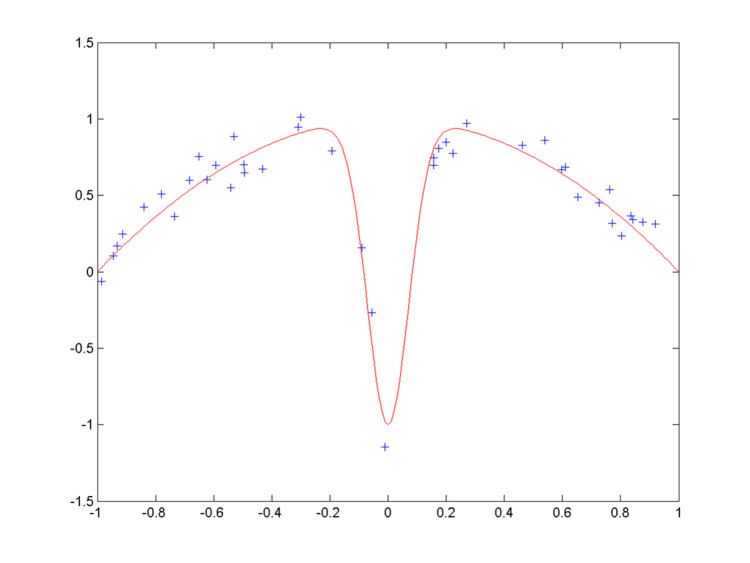 | ||
In statistics and machine learning, the bias–variance tradeoff (or dilemma) is the problem of simultaneously minimizing two sources of error that prevent supervised learning algorithms from generalizing beyond their training set:
Contents
- Motivation
- Biasvariance decomposition of squared error
- Derivation
- Application to regression
- Application to classification
- Approaches
- K nearest neighbors
- Application to human learning
- References
The bias–variance decomposition is a way of analyzing a learning algorithm's expected generalization error with respect to a particular problem as a sum of three terms, the bias, variance, and a quantity called the irreducible error, resulting from noise in the problem itself.
This tradeoff applies to all forms of supervised learning: classification, regression (function fitting), and structured output learning. It has also been invoked to explain the effectiveness of heuristics in human learning.
Motivation
The bias–variance tradeoff is a central problem in supervised learning. Ideally, one wants to choose a model that both accurately captures the regularities in its training data, but also generalizes well to unseen data. Unfortunately, it is typically impossible to do both simultaneously. High-variance learning methods may be able to represent their training set well, but are at risk of overfitting to noisy or unrepresentative training data. In contrast, algorithms with high bias typically produce simpler models that don't tend to overfit, but may underfit their training data, failing to capture important regularities.
Models with low bias are usually more complex (e.g. higher-order regression polynomials), enabling them to represent the training set more accurately. In the process, however, they may also represent a large noise component in the training set, making their predictions less accurate - despite their added complexity. In contrast, models with higher bias tend to be relatively simple (low-order or even linear regression polynomials), but may produce lower variance predictions when applied beyond the training set.
Bias–variance decomposition of squared error
Suppose that we have a training set consisting of a set of points
We want to find a function
Finding an
Where:
and
The expectation ranges over different choices of the training set
The more complex the model
Derivation
The derivation of the bias–variance decomposition for squared error proceeds as follows. For notational convenience, abbreviate
Rearranging, we get:
Since
This, given
Also, since
Thus, since
Application to regression
The bias-variance decomposition forms the conceptual basis for regression regularization methods such as Lasso and Ridge Regression. Regularization methods introduce bias into the regression solution that can reduce variance considerably relative to the OLS solution. Although the OLS solution provides non-biased regression estimates, the lower variance solutions produced by regularization techniques provide superior MSE performance.
Application to classification
The bias–variance decomposition was originally formulated for least-squares regression. For the case of classification under the 0-1 loss (misclassification rate), it's possible to find a similar decomposition. Alternatively, if the classification problem can be phrased as probabilistic classification, then the expected squared error of the predicted probabilities with respect to the true probabilities can be decomposed as before.
Approaches
Dimensionality reduction and feature selection can decrease variance by simplifying models. Similarly, a larger training set tends to decrease variance. Adding features (predictors) tends to decrease bias, at the expense of introducing additional variance. Learning algorithms typically have some tunable parameters that control bias and variance, e.g.:
One way of resolving the trade-off is to use mixture models and ensemble learning. For example, boosting combines many "weak" (high bias) models in an ensemble that has lower bias than the individual models, while bagging combines "strong" learners in a way that reduces their variance.
K-nearest neighbors
In the case of k-nearest neighbors regression, a closed-form expression exists that relates the bias–variance decomposition to the parameter k:
where
Application to human learning
While widely discussed in the context of machine learning, the bias-variance dilemma has been examined in the context of human cognition, most notably by Gerd Gigerenzer and co-workers in the context of learned heuristics. They have argued (see references below) that the human brain resolves the dilemma in the case of the typically sparse, poorly-characterised training-sets provided by experience by adopting high-bias/low variance heuristics. This reflects the fact that a zero-bias approach has poor generalisability to new situations, and also unreasonably presumes precise knowledge of the true state of the world. The resulting heuristics are relatively simple, but produce better inferences in a wider variety of situations.
Geman et al. argue that the bias-variance dilemma implies that abilities such as generic object recognition cannot be learned from scratch, but require a certain degree of “hard wiring” that is later tuned by experience. This is because model-free approaches to inference require impractically large training sets if they are to avoid high variance.
